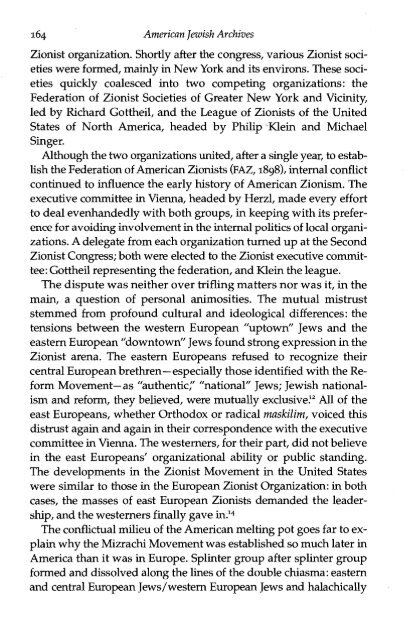Create successful ePaper yourself
Turn your PDF publications into a flip-book with our unique Google optimized e-Paper software.
164 <strong>American</strong> <strong>Jewish</strong> <strong>Archives</strong><br />
Zionist organization. Shortly after the congress, various Zionist soci-<br />
eties were formed, mainly in New York and its environs. These soci-<br />
eties quickly coalesced into two competing organizations: the<br />
Federation of Zionist Societies of Greater New York and Vicinity,<br />
led by Richard Gottheil, and the League of Zionists of the United<br />
States of North America, headed by Philip Klein and Michael<br />
Singer.<br />
Although the two organizations united, after a single year, to estab-<br />
lish the Federation of <strong>American</strong> Zionists (FAZ, 1898), internal conflict<br />
continued to influence the early history of <strong>American</strong> Zionism. The<br />
executive committee in Vienna, headed by Herzl, made every effort<br />
to deal evenhandedly with both groups, in keeping with its prefer-<br />
ence for avoiding involvement in the internal politics of local organi-<br />
zations. A delegate from each organization turned up at the Second<br />
Zionist Congress; both were elected to the Zionist executive cornrnit-<br />
tee: Gottheil representing the federation, and Klein the league.<br />
The dispute was neither over trifling matters nor was it, in the<br />
main, a question of personal animosities. The mutual mistrust<br />
stemmed from profound cultural and ideological differences: the<br />
tensions between the westem European "uptown" Jews and the<br />
eastern European "downtown" Jews found strong expression in the<br />
Zionist arena. The eastern Europeans refused to recognize their<br />
central European brethren- especially those identified with the Re-<br />
form Movement- as "authentic: "national" Jews; <strong>Jewish</strong> national-<br />
ism and reform, they believed, were mutually exclusive." All of the<br />
east Europeans, whether Orthodox or radical maskilim, voiced this<br />
distrust again and again in their correspondence with the executive<br />
committee in Vienna. The westemers, for their part, did not believe<br />
in the east Europeans' organizational ability or public standing.<br />
The developments in the Zionist Movement in the United States<br />
were similar to those in the European Zionist Organization: in both<br />
cases, the masses of east European Zionists demanded the leader-<br />
ship, and the westerners finally gave in.'4<br />
The conflictual milieu of the <strong>American</strong> melting pot goes far to ex-<br />
plain why the Mizrachi Movement was established so much later in<br />
America than it was in Europe. Splinter group after splinter group<br />
formed and dissolved along the lines of the double chiasma: eastern<br />
and central European Jews/western European Jews and halachically

















